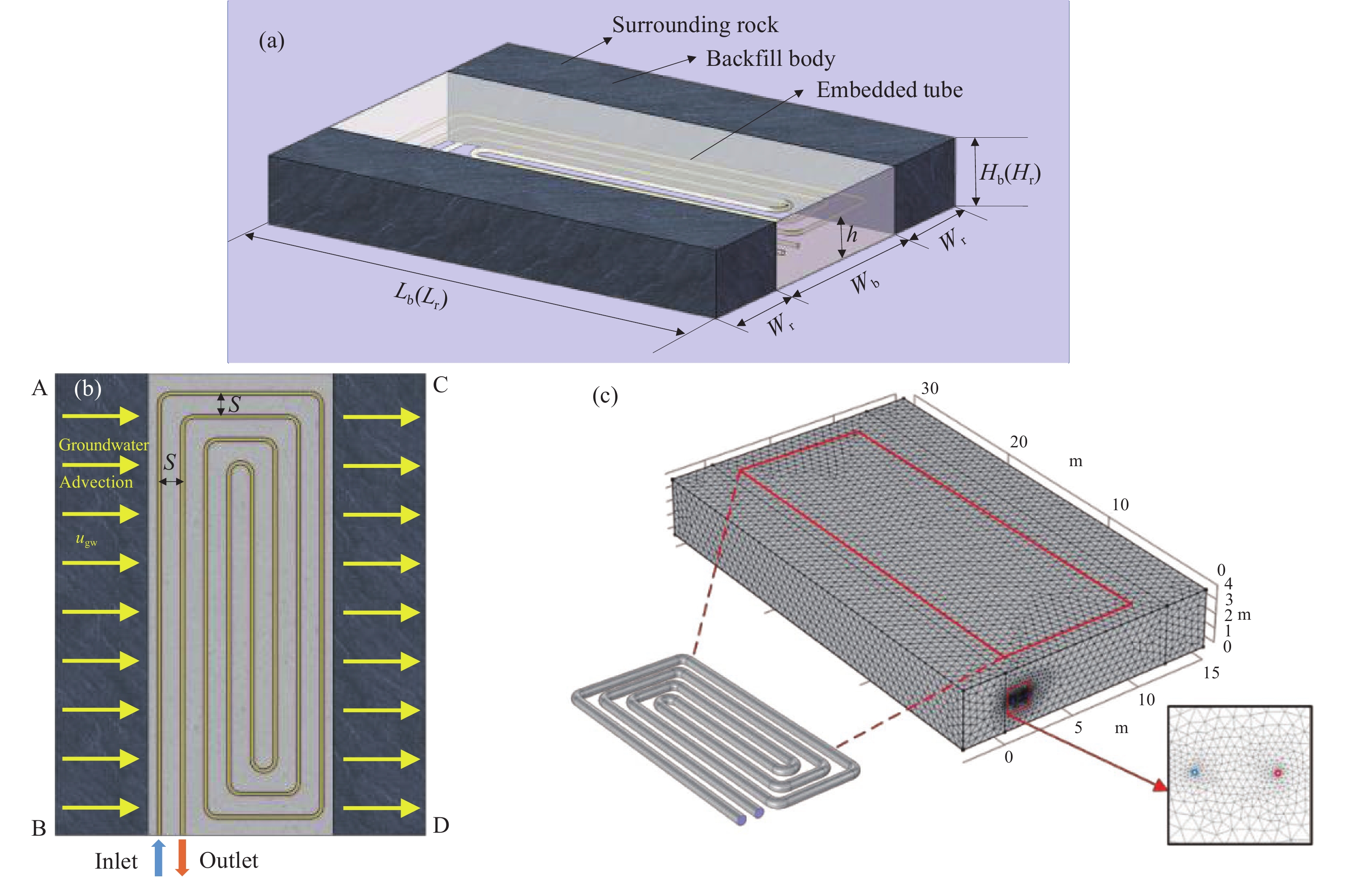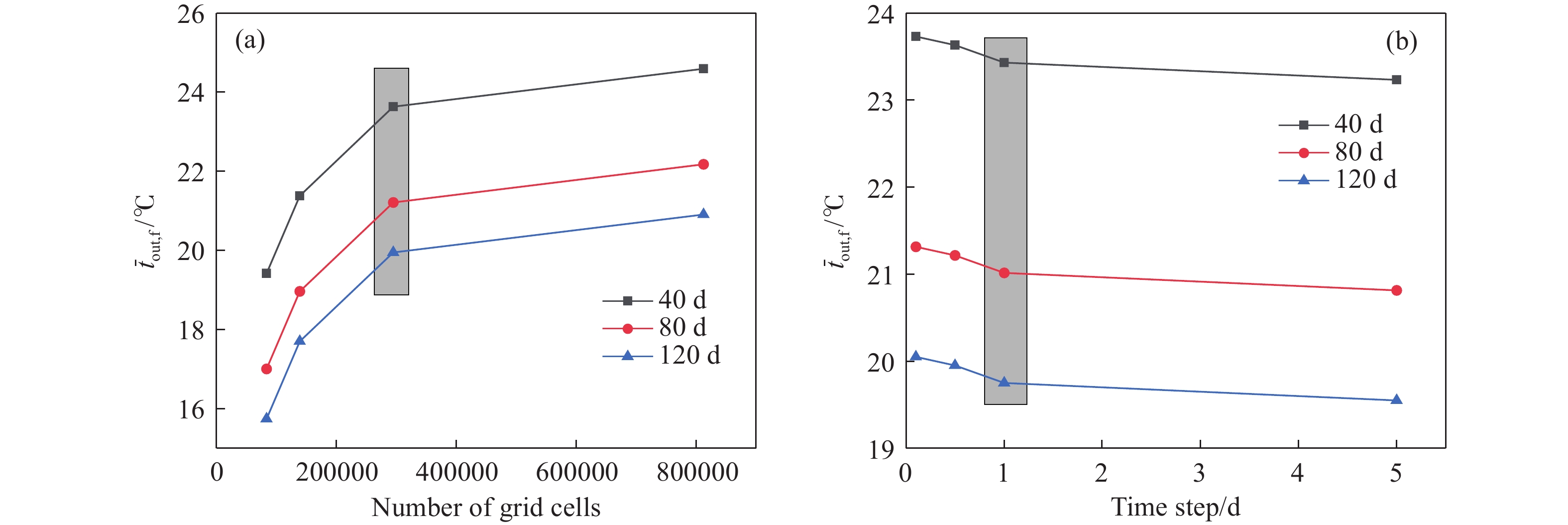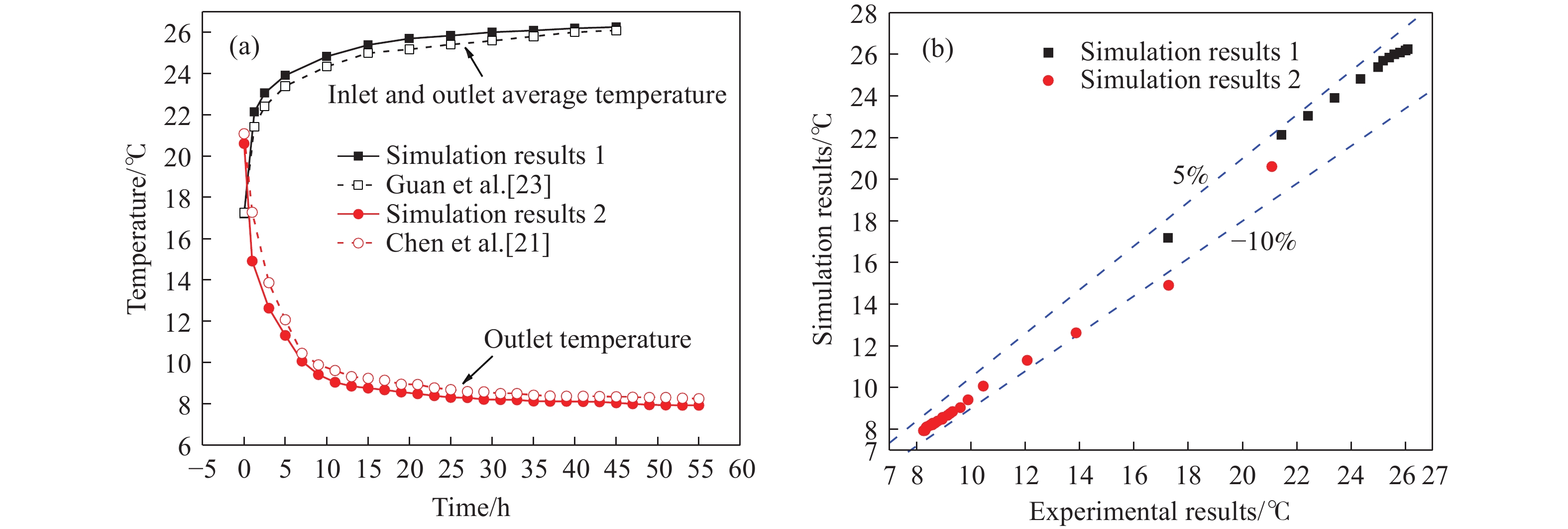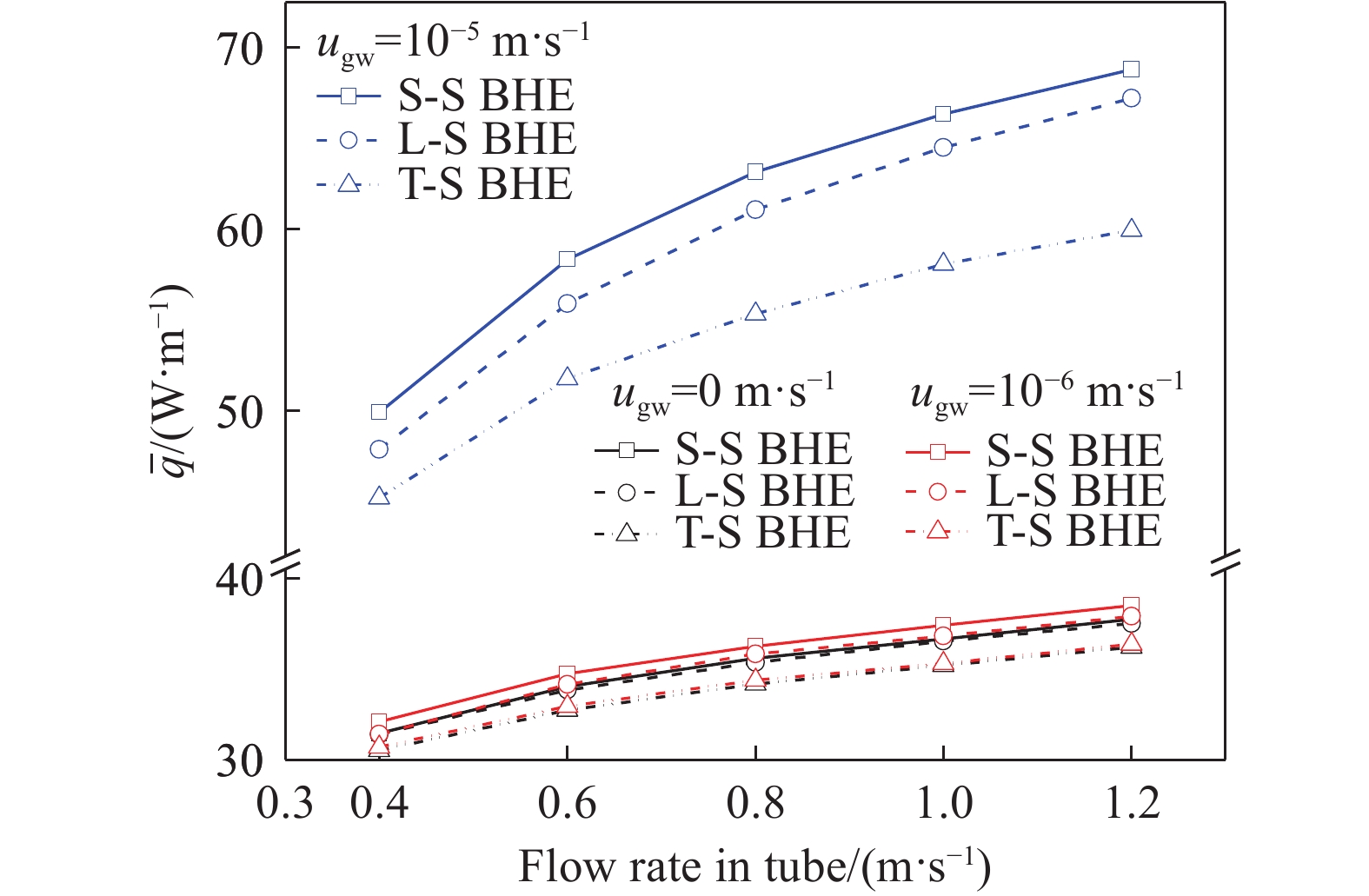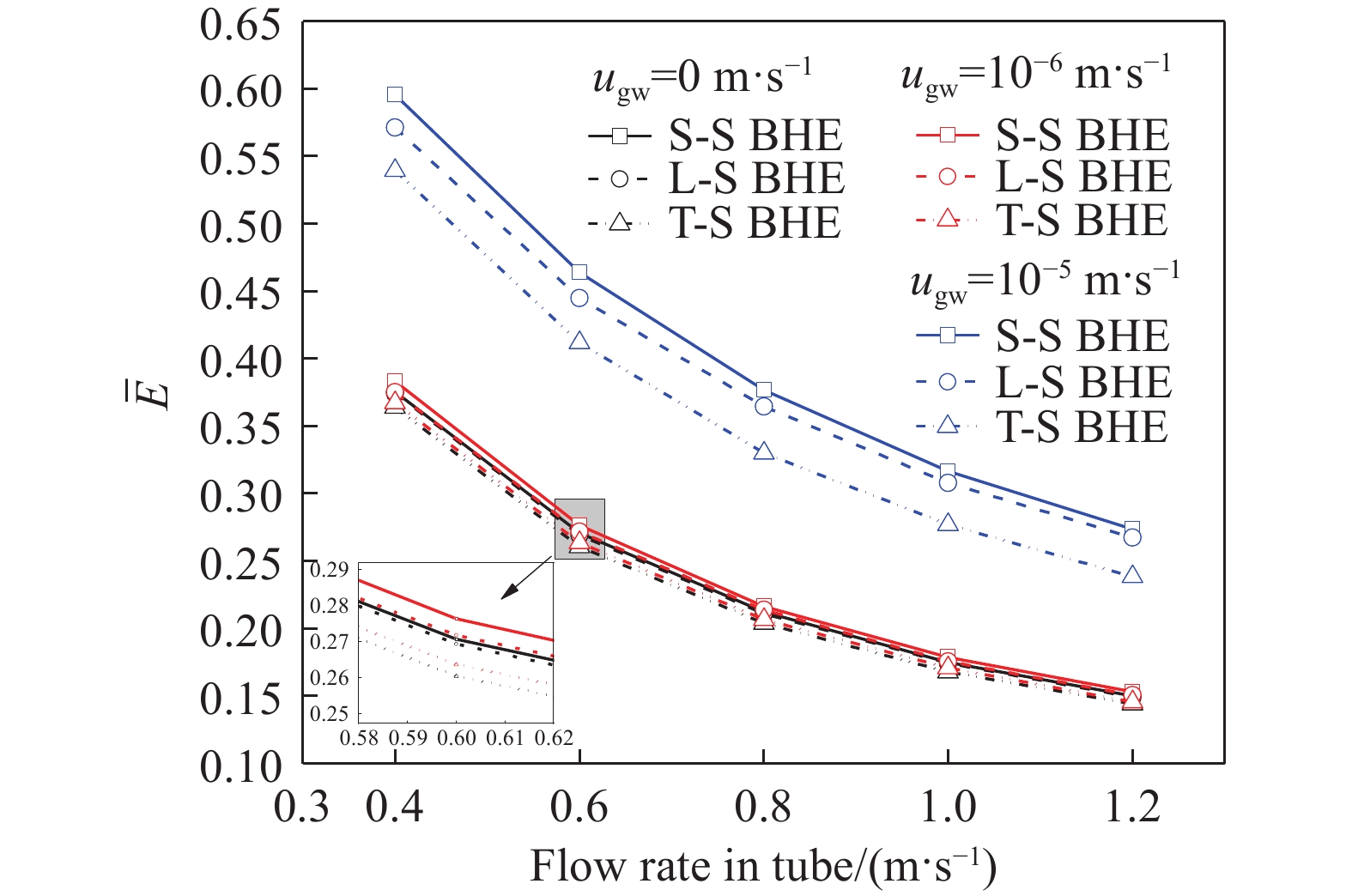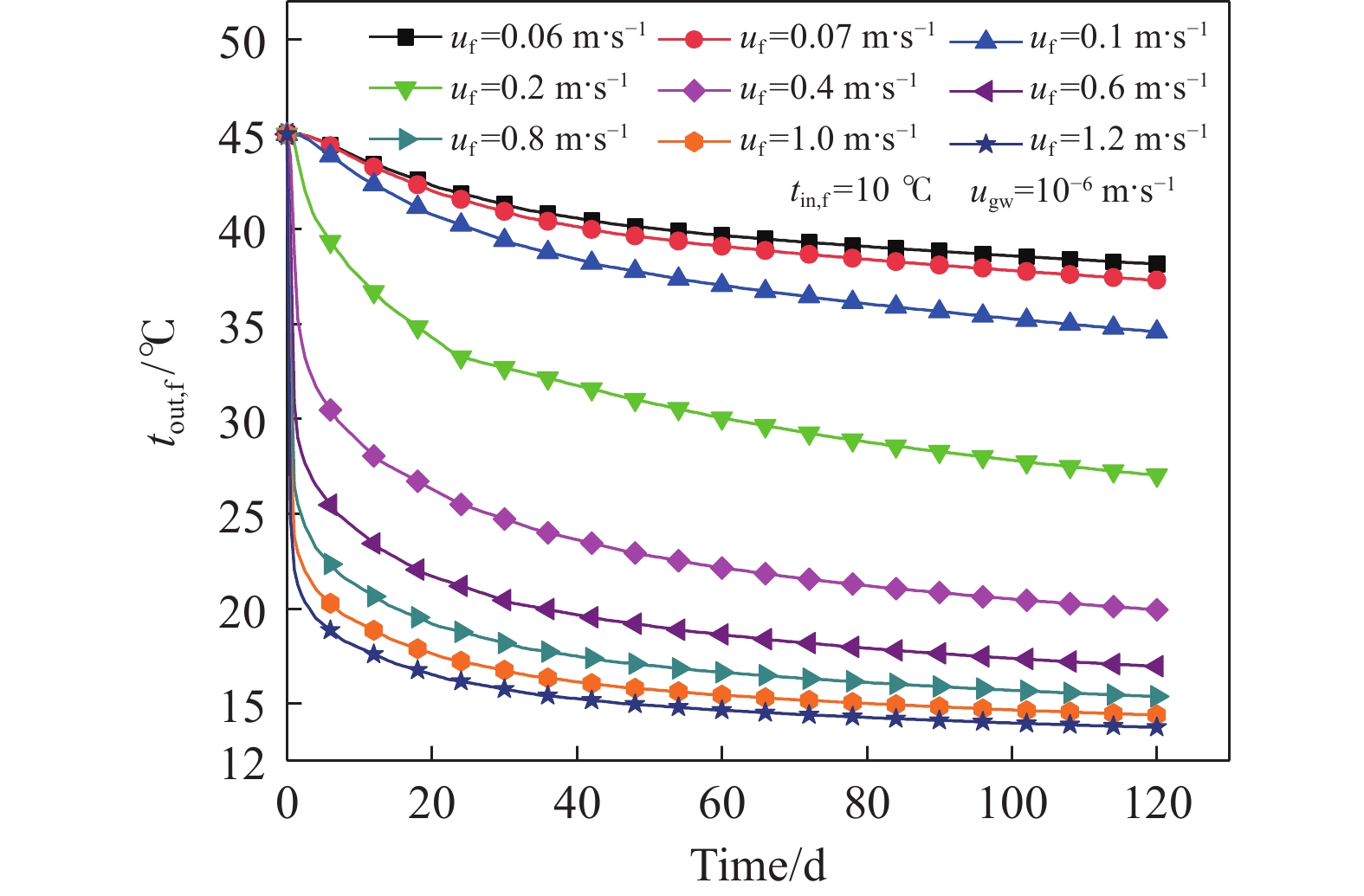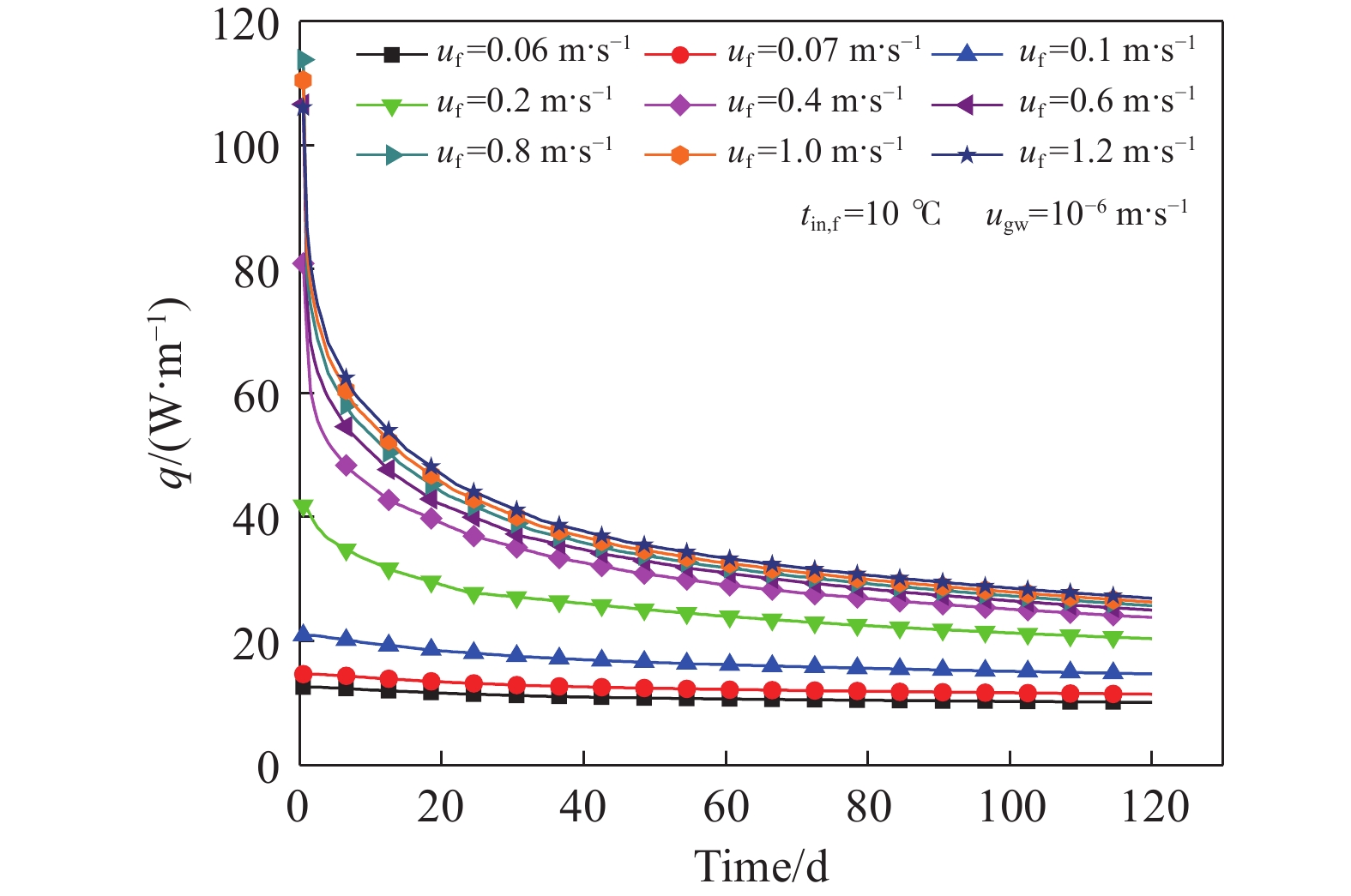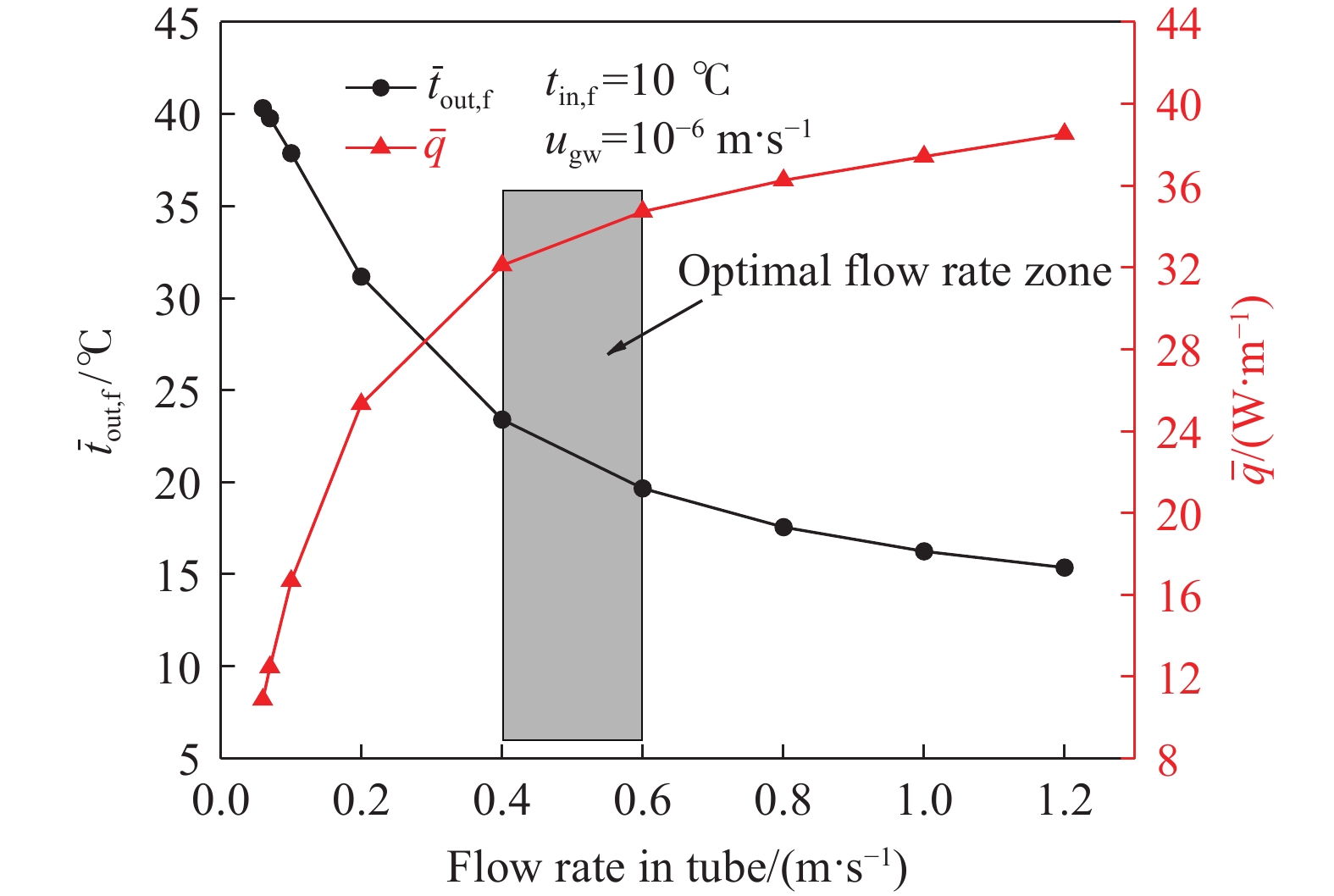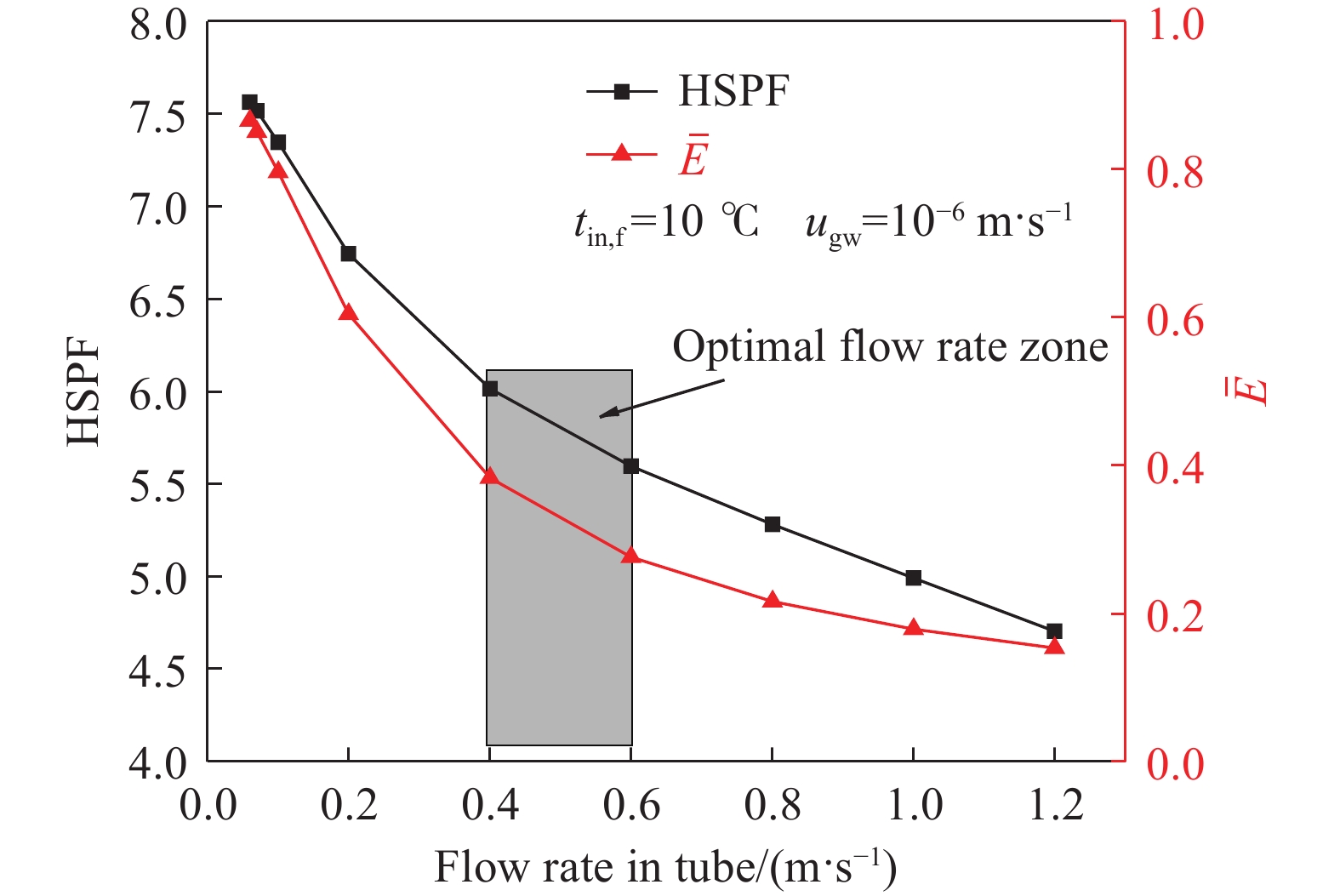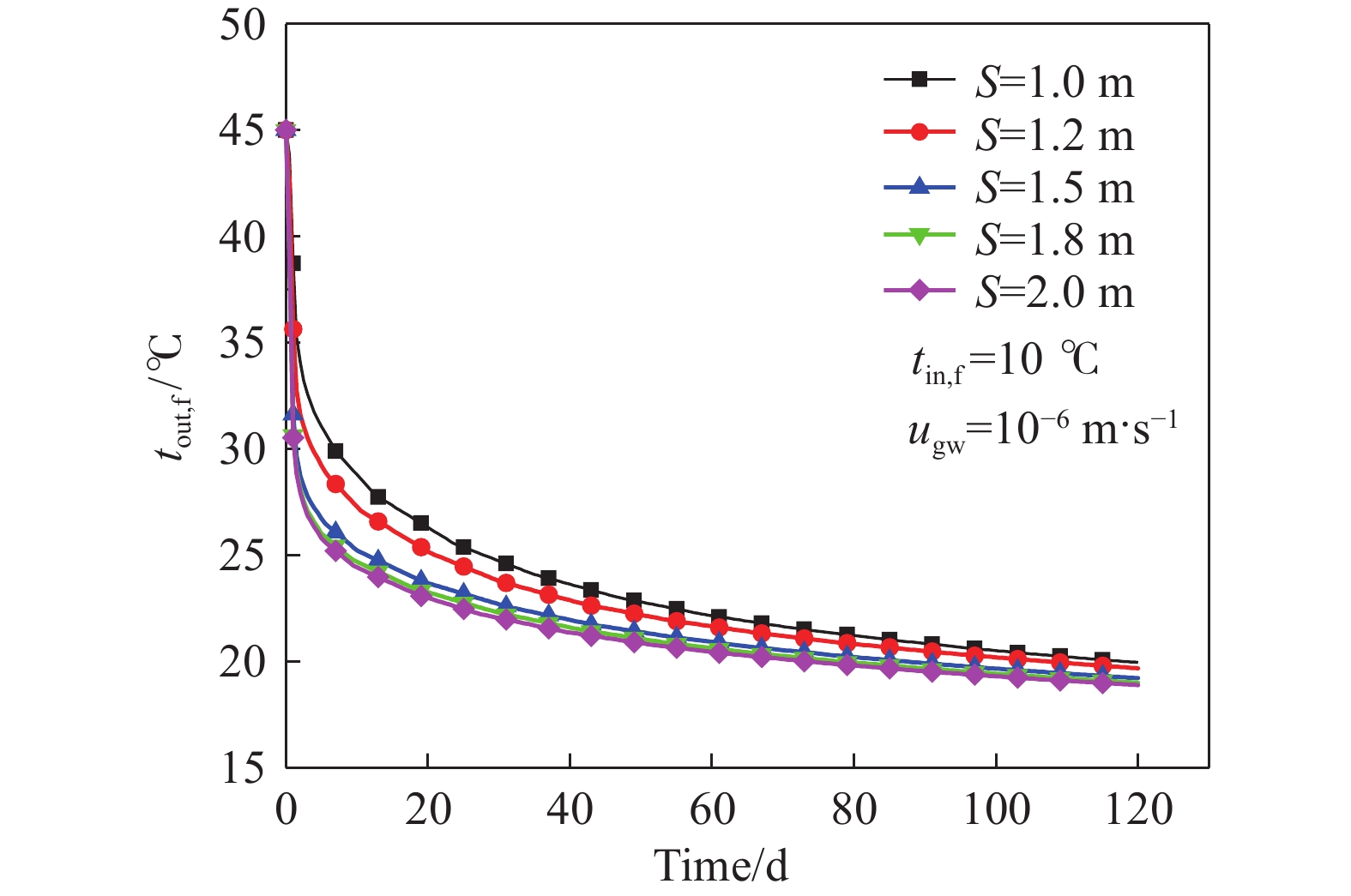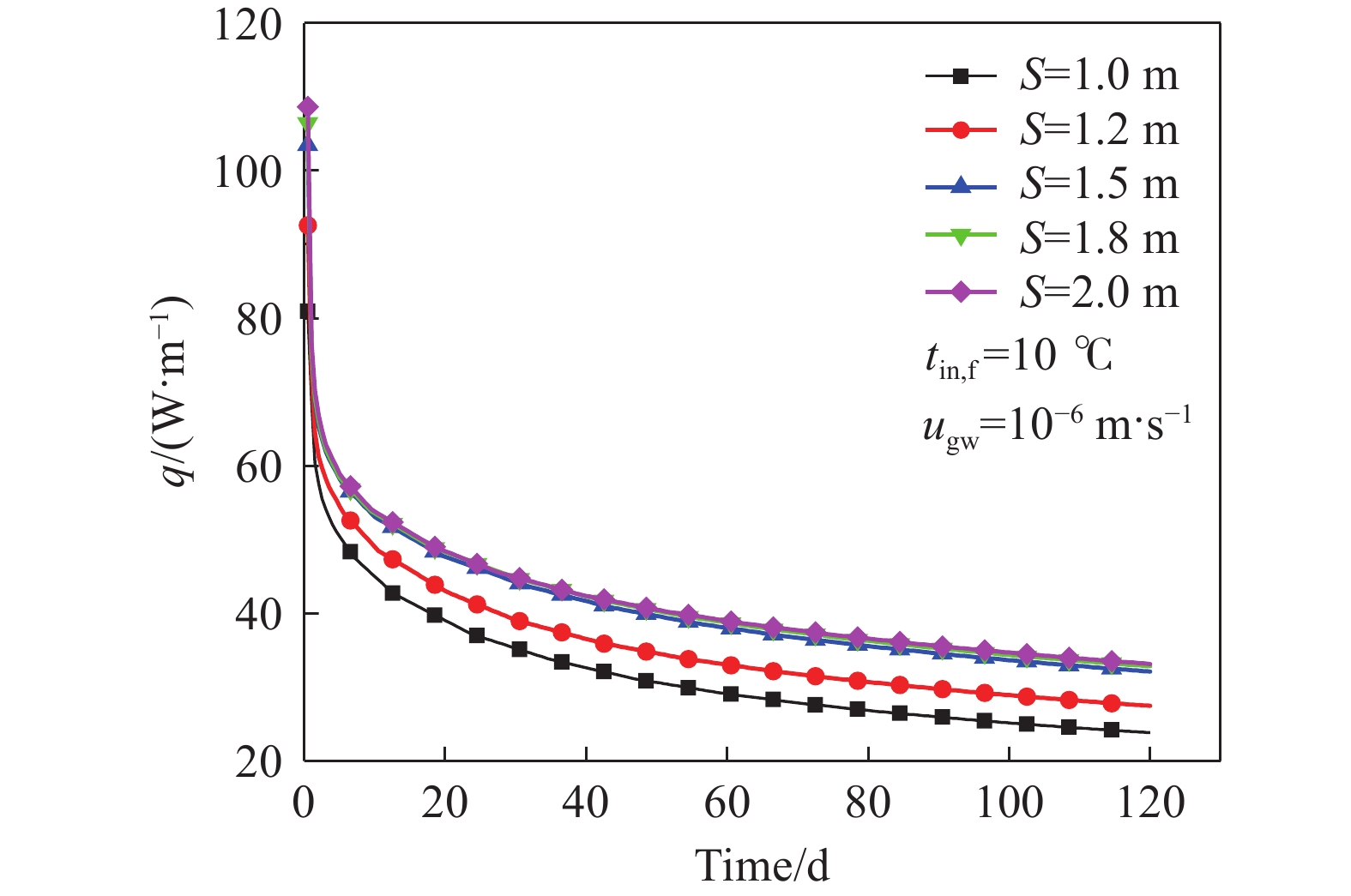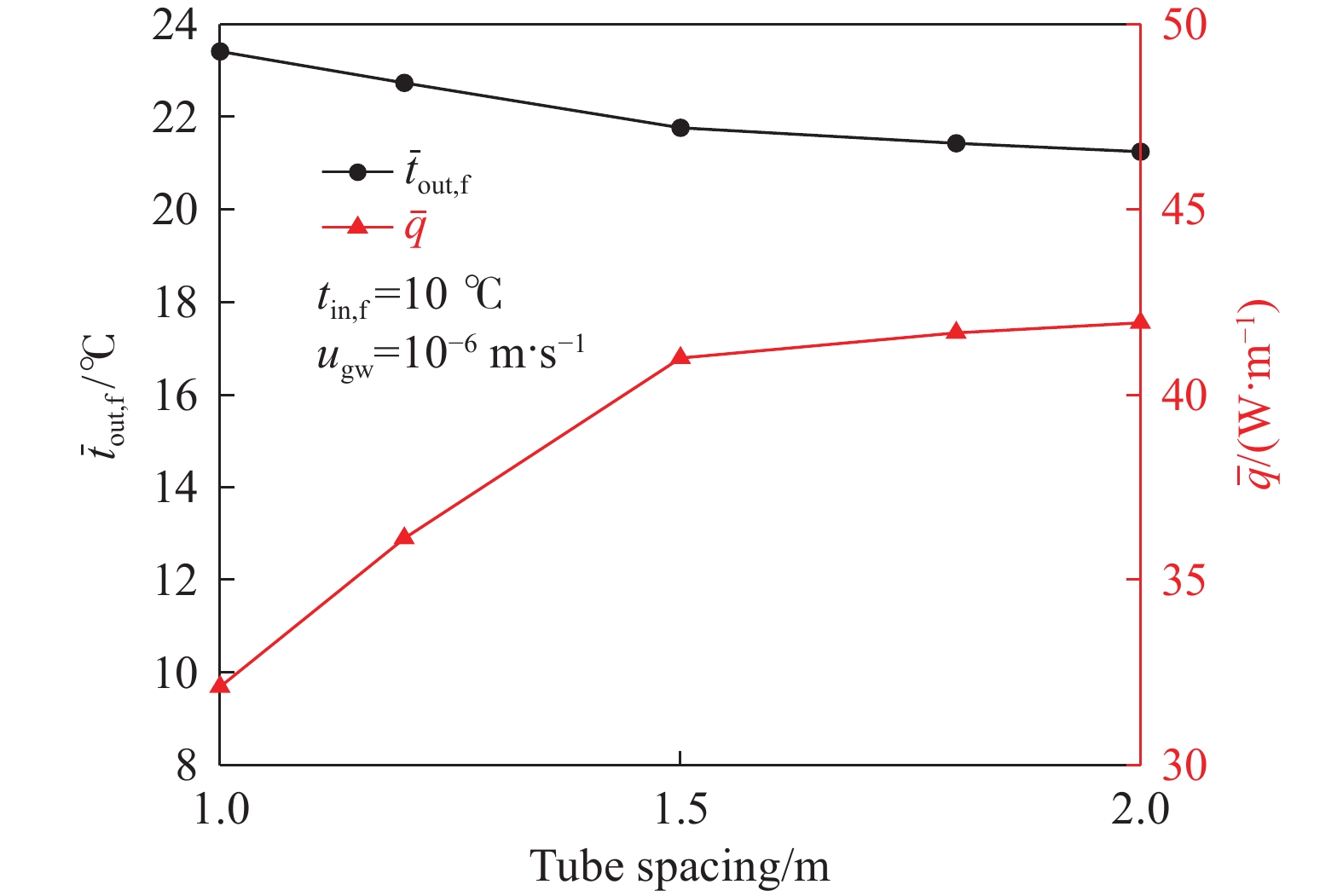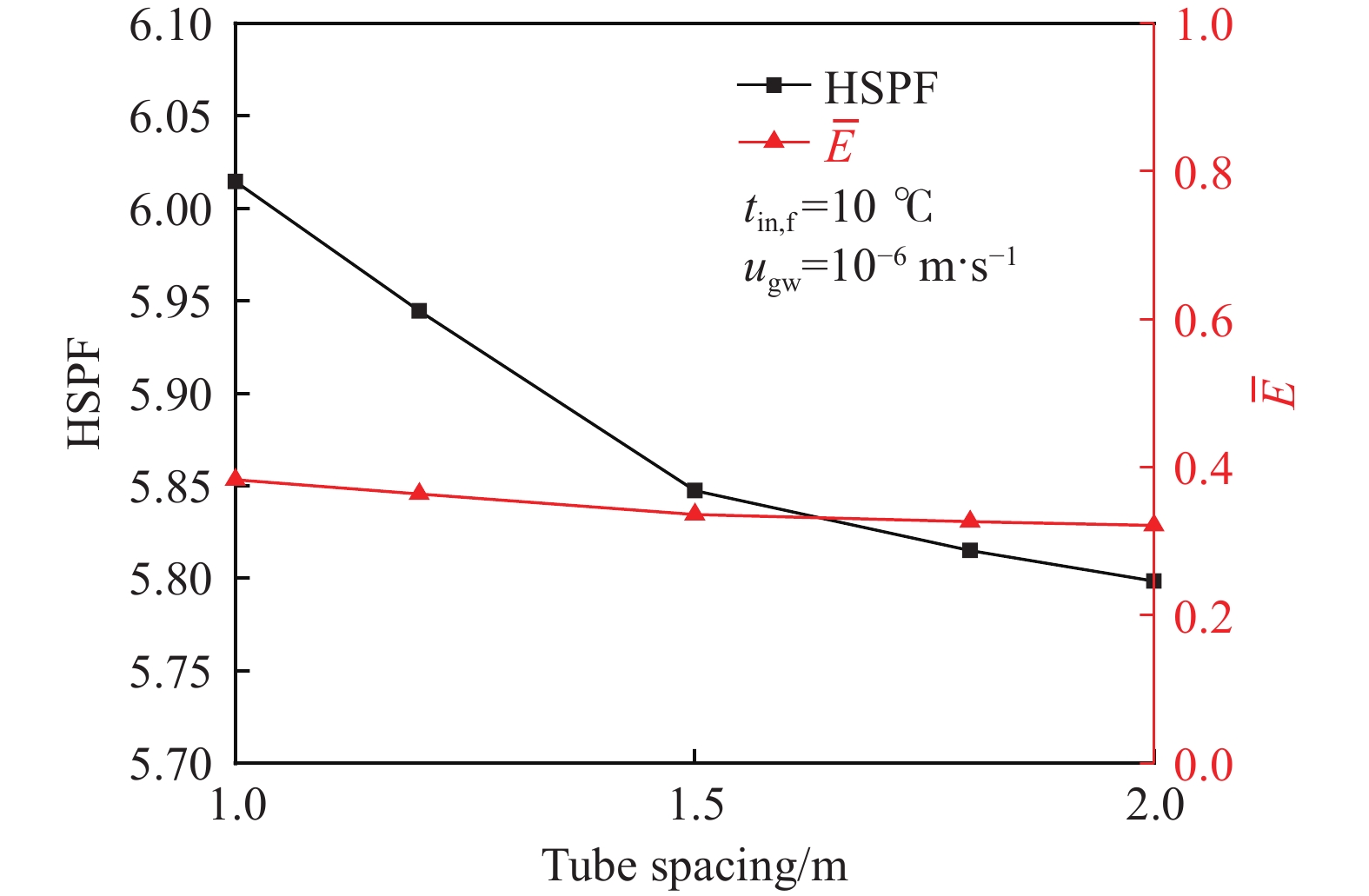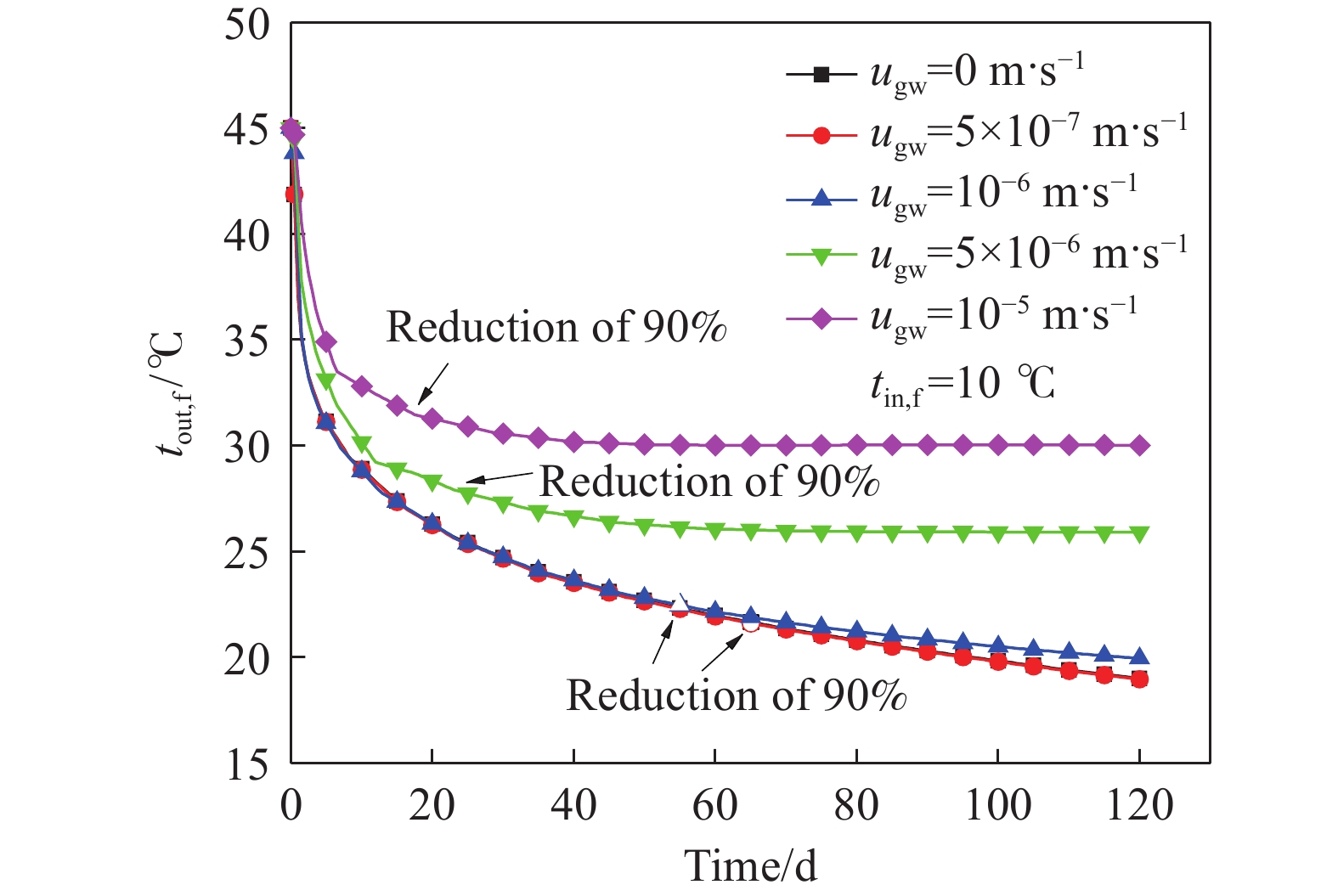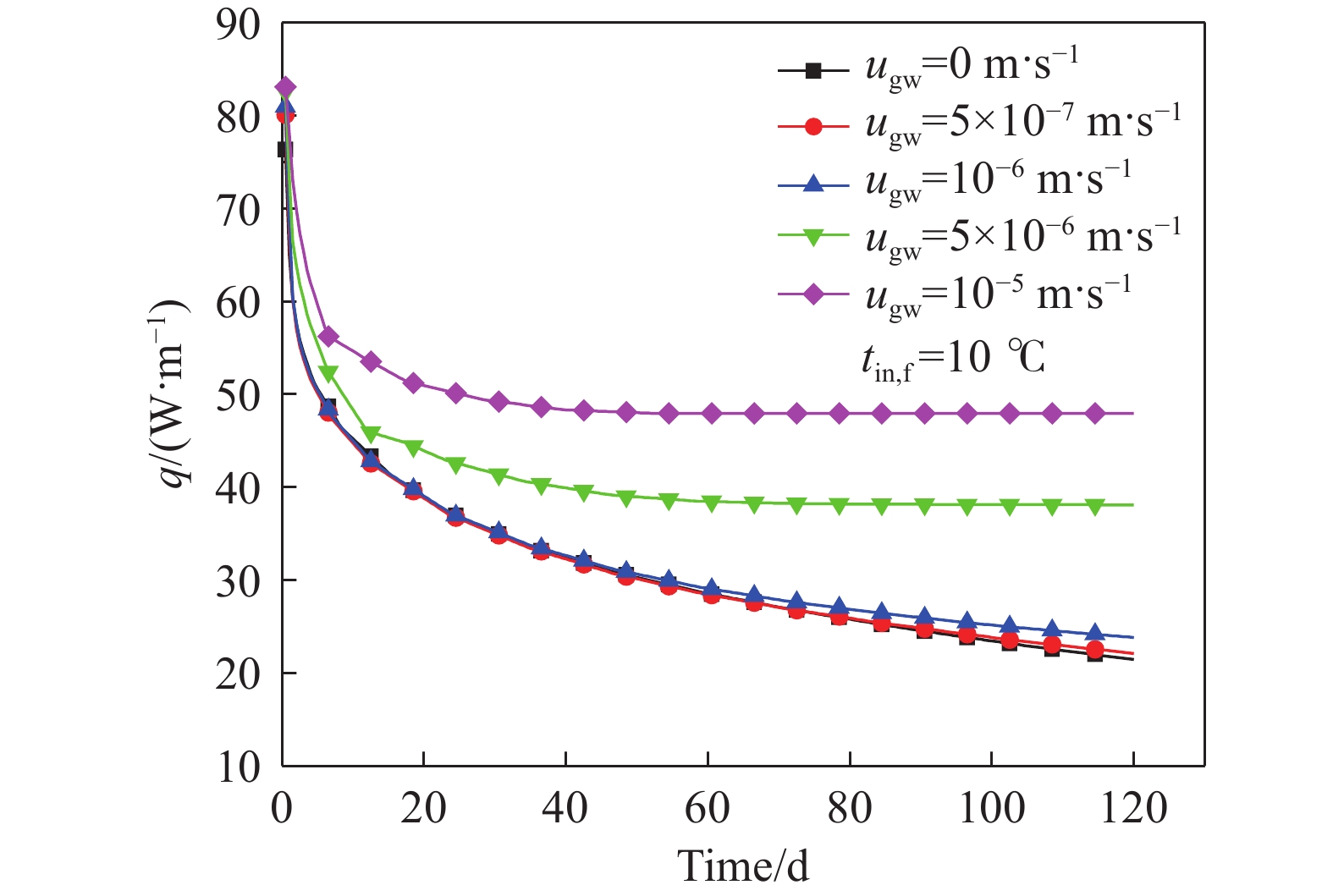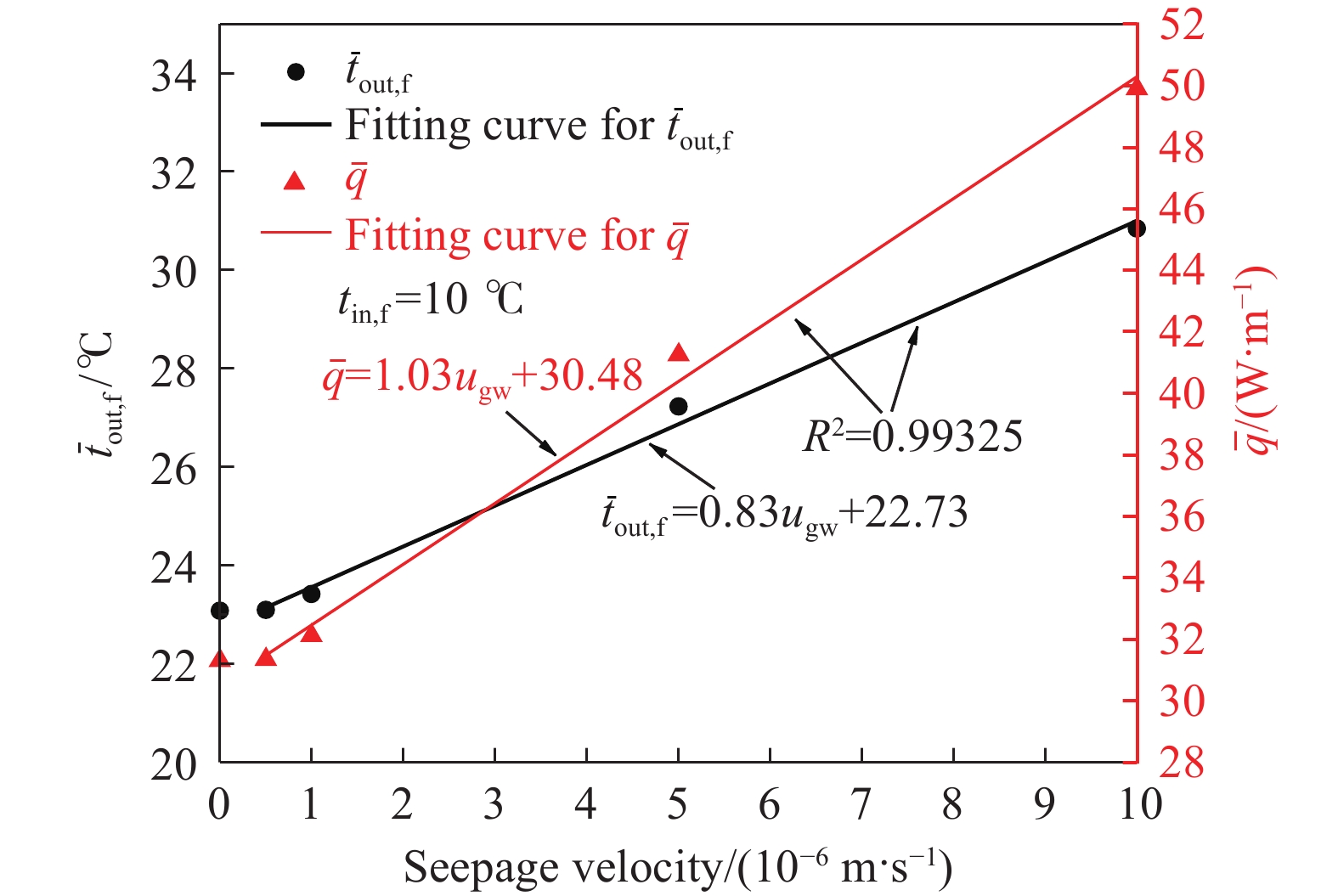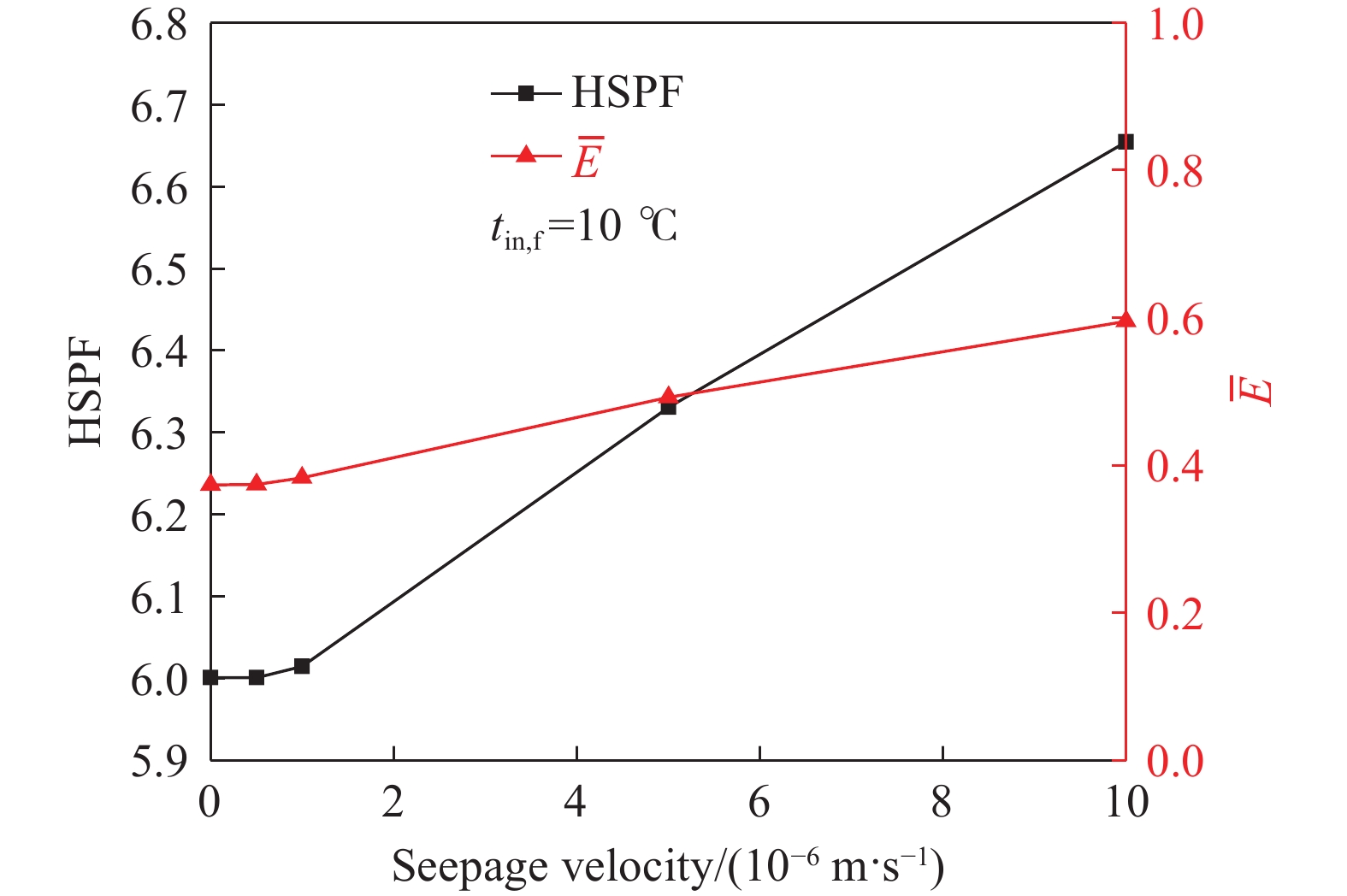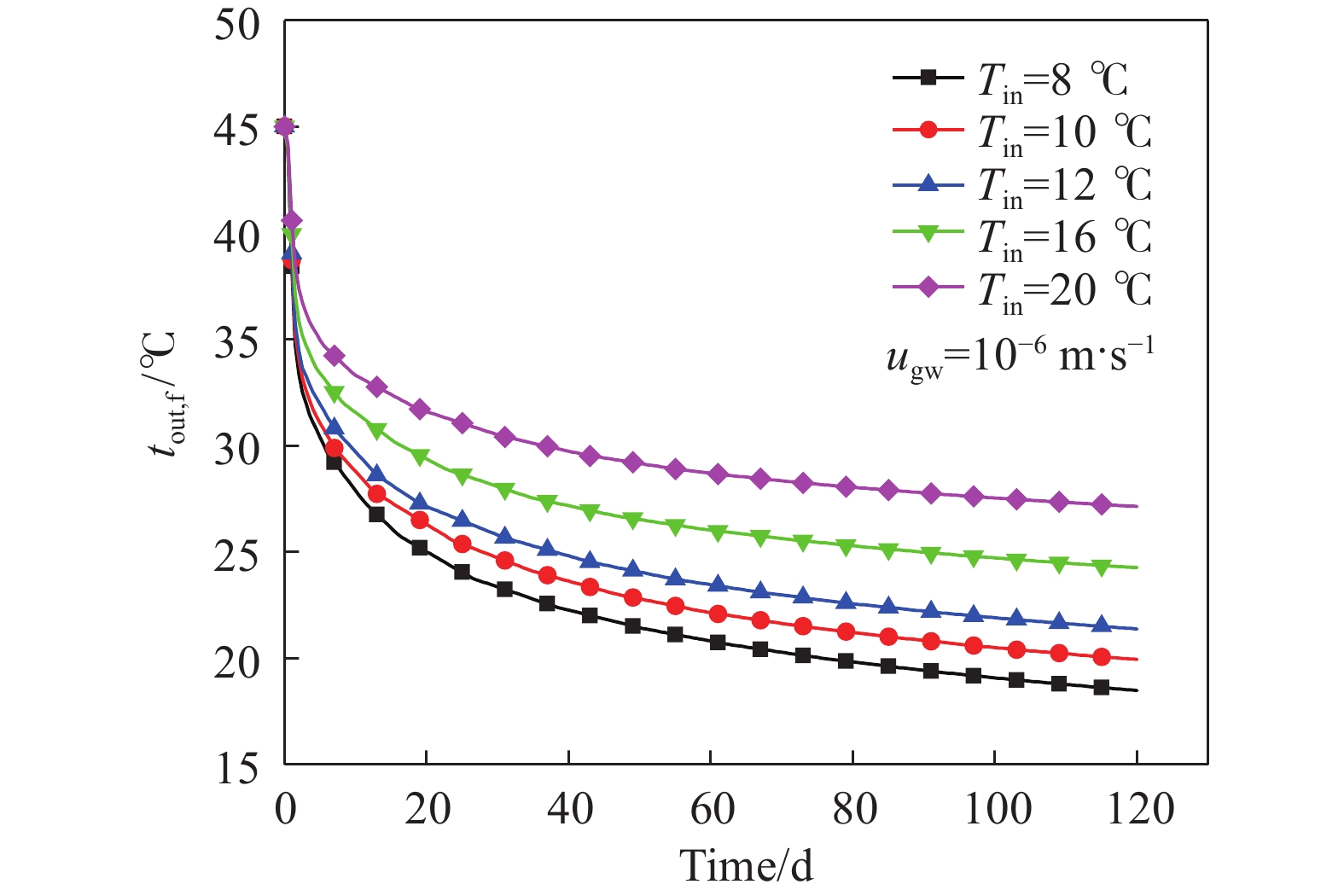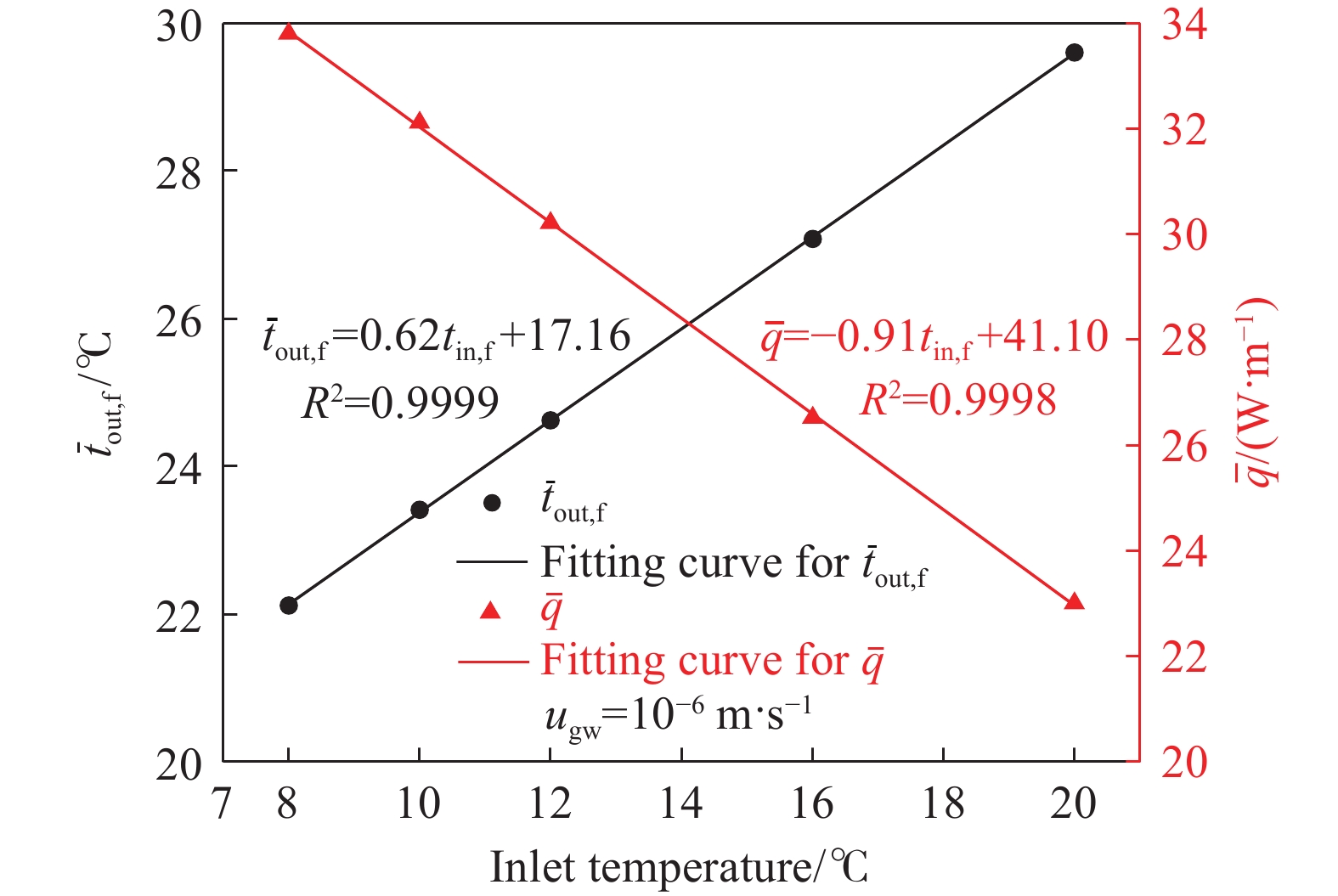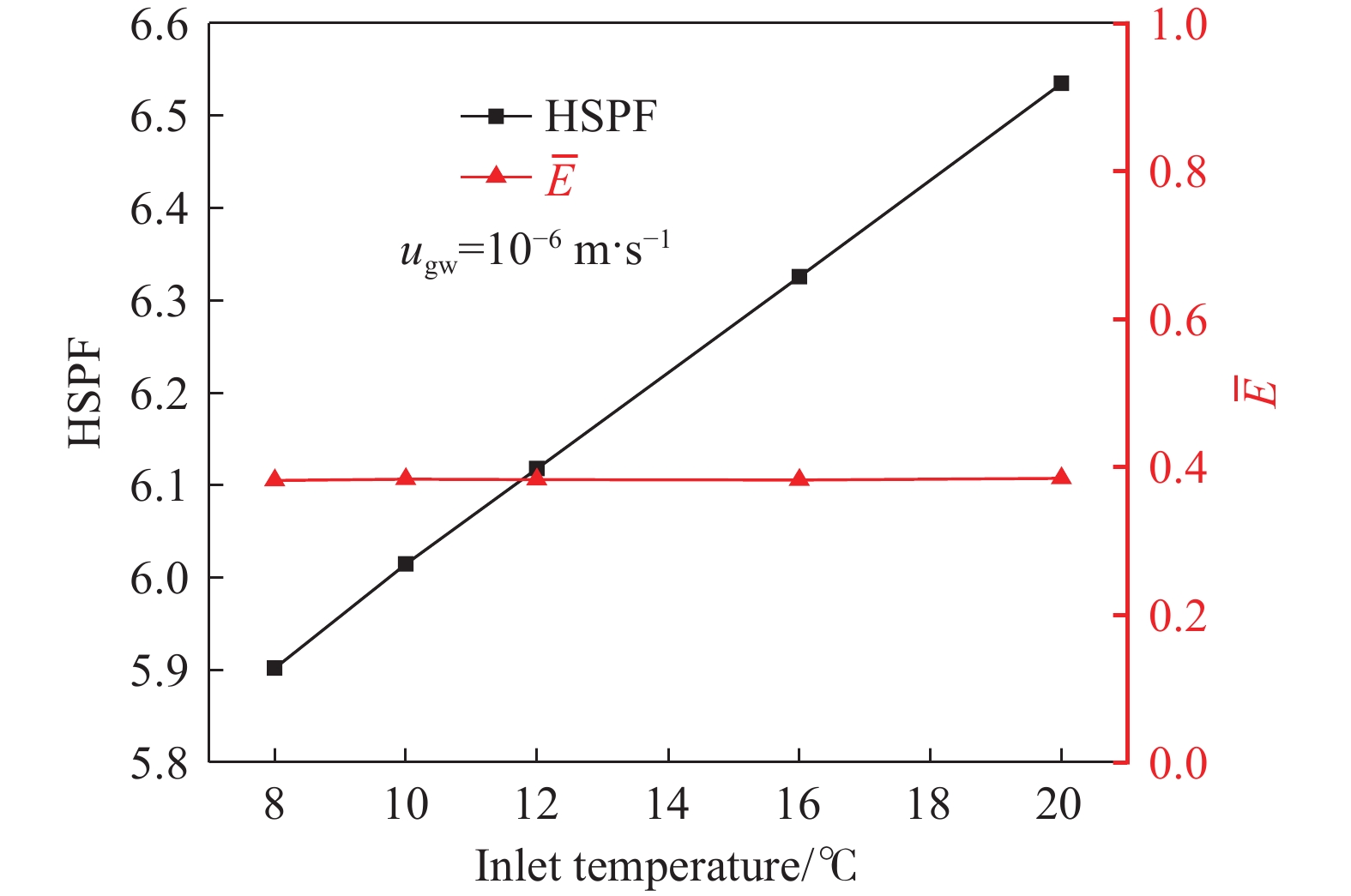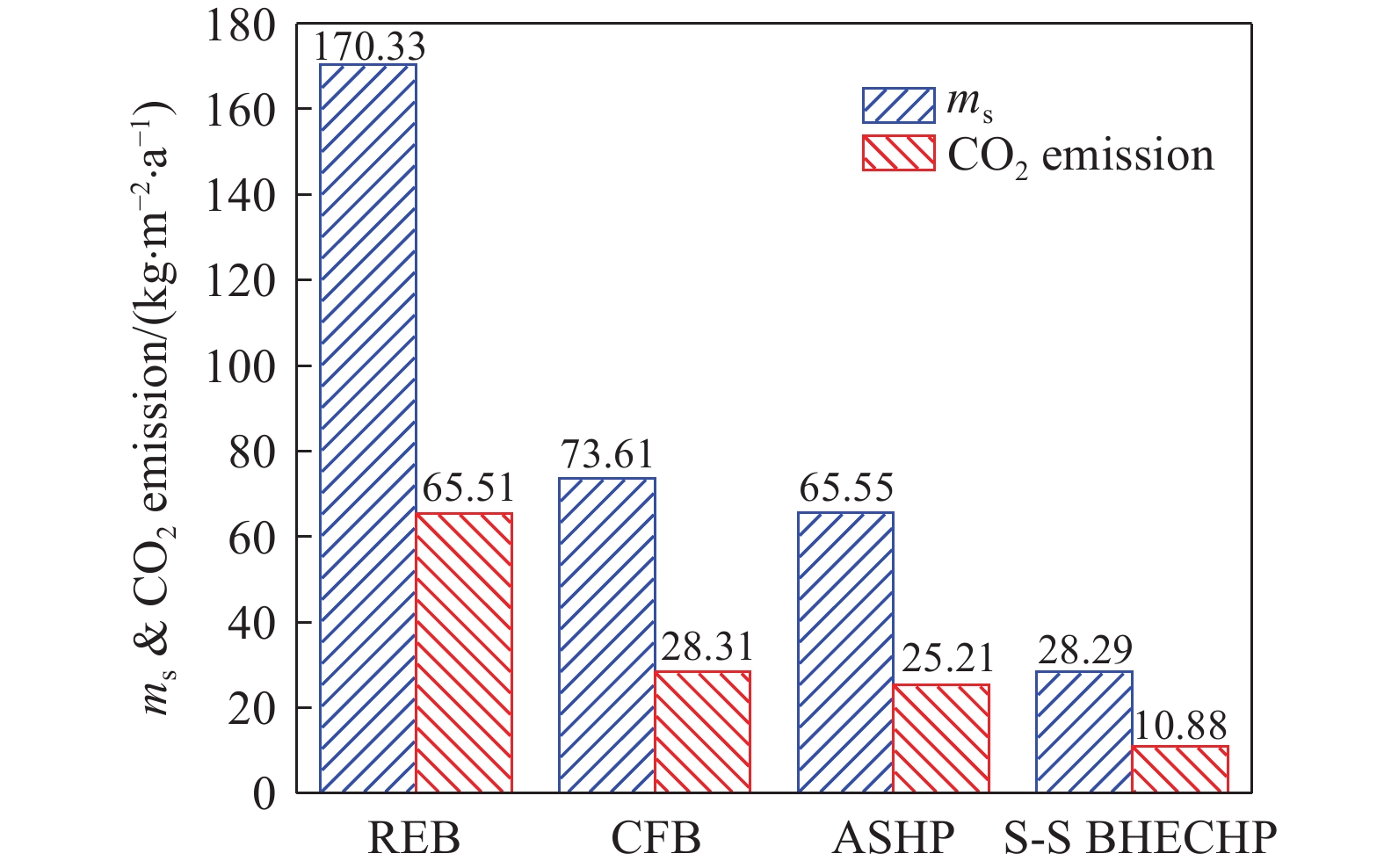Performance of a horizontal square-spiral-type backfill heat exchanger in a deep mine and its coupled heat pump system
-
摘要: 深部礦井蘊藏著大量地熱資源,功能性充填體技術將深部采礦和深部地熱開采相結合,實現礦產和地熱資源開發共贏,是延長深部礦山壽命的重要舉措。本文在分析了國內外充填礦井通過埋管提取地熱資源現狀基礎上,提出了一種水平方螺旋形埋管充填體換熱器(Square-spiral-type backfill heat exchangers,S-S BHE)。考慮到地下水滲流對礦井埋管充填體換熱器(Backfill heat exchangers,BHE)取熱影響顯著但前期研究相對不足,利用COMSOL軟件建立了三維非穩態BHE熱滲耦合模型并驗證了其可靠性。在此基礎上,建立了埋管充填體換熱器耦合熱泵(Backfill heat exchangers coupled heat pump,BHECHP)數學模型及四個綜合評價指標。首先,在相同幾何條件和物理條件下,對比分析了S-S BHE與兩種典型蛇形BHE的性能,結果表明:S-S BHE的綜合評價指標均優于蛇形BHE,且在較高滲流條件下優勢更加顯著。其次,研究了管內流速、管間距、滲流速度和入口水溫對S-S BHE及其耦合熱泵特性的影響規律,研究發現:管內流速和滲流速度對綜合評價指標的影響最為顯著,管內流速越高,單位管長平均換熱功率越高,但制熱季節能效明顯降低。分析認為管內流速存在0.4~0.6 m·s–1的最優區間,此時管內循環水流動處于從過渡區向旺盛湍流轉變。滲流速度在小于10–6 m·s–1時的影響可以忽略不計,在10–6~10–5 m·s–1的常見滲流范圍內,綜合評價指標均呈線性遞增的趨勢。最后,對方螺旋形埋管充填體換熱器耦合熱泵(Square-spiral-type backfill heat exchangers coupled heat pump,S-S BHECHP)進行了生態評價。通過與傳統供暖方式對比發現:采用S-S BHECHP的供暖方式具有顯著的節能降碳效果,一次能源消費和碳排放量比蓄熱式電鍋爐、燃煤鍋爐和空氣源熱泵相應降低了83.39%、61.57%和56.84%。本研究結果展示了方螺旋形BHE和BHECHP的優良性能,為蓄熱儲能式功能性充填在深部礦井的應用與探索提供了理論指導。Abstract: Geothermal resources are abundant in deep mines. Functional backfill technology combines deep mining and deep geothermal mining to achieve a win-win situation for mineral and geothermal resource development and is an important measure for extending the life of deep mines. In this paper, on the basis of an analysis of the research status of geothermal resource extraction through tubes embedded in backfill bodies in mines, a horizontal square-spiral-type backfill heat exchangers (S-S BHE) is proposed. Considering the significant influence of groundwater advection on the heat extraction of backfill heat exchangers (BHE) in mines and the relative scarcity of previous studies, a verified three-dimensional unsteady BHE model coupling heat transfer and seepage are established using COMSOL software. Based on this model, a mathematical model of the backfill heat exchanger coupled heat pump (BHECHP), and four comprehensive evaluation indicators are established. Firstly, the performance of the S-S BHE is compared with that of two typical serpentine BHEs under the same geometric and physical conditions. The results show that the S-S BHE performs better than the two serpentine BHEs across the board, and the advantage is more substantial under situations of higher permeability flow. Secondly, the characteristics of the S-S BHE and its coupled heat pump are examined in relation to the in-tube flow rate, tube spacing, seepage velocity, and inlet water temperature. The in-tube flow rate and seepage velocity are found to have the most significant effects on the comprehensive evaluation indicators. The average heat transfer power per unit of tube length increases with flow rate, but the heating seasonal performance factor (HSPF) decreases obviously. The analysis revealed an optimum interval of 0.4–0.6 m·s?1 for the flow rate in the tube, where the flow of circulating water in the tube is in transition from the transition zone to the fully turbulent flow zone. The effect of seepage velocity is negligible at less than 10–6 m·s?1, and all comprehensive evaluation indicators present linearly increasing trends in the usual seepage range of 10–6 to 10–5 m·s?1. Finally, an ecological evaluation of the S-S BHECHP was conducted. A comparison with traditional heating methods reveals that the heating method using S-S BHECHP has a significant energy saving and carbon reduction effect. The primary energy consumption and carbon emissions of the S-S BHECHP are reduced by 83.39%, 61.57%, and 56.84% compared to the regenerative electric boiler, coal-fired boiler, and air-source heat pump, respectively. The findings of this study show how well the S-S BHE and the S-S BHECHP performance, and they also provide some theoretical recommendations for the application and exploration of heat storage/energy storage functional backfill in deep mines.
-
表 1 模型幾何條件
Table 1. Model geometric conditions
Type Parameters Value Default value Backfill body Lb × Wb × Hb (Length × width × height) 30 m × 12 m × 4 m — Surrounding rock Lr × Wr × Hr (Length × width × height) 30 m × 6 m × 4 m — Embedded tube di (Inner diameter of the tube) 20–50 mm 25 mm S (Tube spacing) 1–2 m 1.0 m h (Height of embedded tube position) 2 m — 表 2 模型物理條件
Table 2. Model physical conditions
Type Density / (kg·m?3) Specific heat / (J·kg?1·K?1) Thermal conductivity / (W·m?1·K–1) Porosity / % Permeability / m2 Circulating water/groundwater 998 4187 0.6 — — Embedded copper tubes 8500 393.6 110 — — Backfill body 1709 1235 0.6 30 0.04 Surrounding rock 2400 2000 2.5 25 0.03 久色视频表 3 不同供熱方式的一次能源利用率
Table 3. Primary energy efficiency of different heating methods
-
參考文獻
[1] Cai M F, Xue D L, Ren F H. Current status and development strategy of metal mines. Chin J Eng, 2019, 41(4): 417蔡美峰, 薛鼎龍, 任奮華. 金屬礦深部開采現狀與發展戰略. 工程科學學報, 2019, 41(4):417 [2] Cai M F, Li P, Tan W H, et al. Key engineering technologies to achieve green, intelligent, and sustainable development of deep metal mines in China. Engineering, 2021, 7(11): 1513 doi: 10.1016/j.eng.2021.07.010 [3] He M C, Guo P Y. Deep rock mass thermodynamic effect and temperature control measures. Chin J Rock Mech Eng, 2013, 32(12): 2377何滿潮, 郭平業. 深部巖體熱力學效應及溫控對策. 巖石力學與工程學報, 2013, 32(12):2377 [4] Jessop A M, MacDonald J K, Spence H. Clean energy from abandoned mines at springhill, nova Scotia. Energy Sources, 1995, 17(1): 93 doi: 10.1080/00908319508946072 [5] Hall A, Scott J A, Shang H. Geothermal energy recovery from underground mines. Renew Sustain Energy Rev, 2011, 15(2): 916 doi: 10.1016/j.rser.2010.11.007 [6] Watzlaf G R, Ackman T E. Underground mine water for heating and cooling using geothermal heat pump systems. Mine Water Environ, 2006, 25(1): 1 doi: 10.1007/s10230-006-0103-9 [7] Kranz K, Dillenardt J. Mine water utilization for geothermal purposes in freiberg, Germany: Determination of hydrogeological and thermophysical rock parameters. Mine Water Environ, 2010, 29(1): 68 doi: 10.1007/s10230-009-0094-4 [8] Mustafa Omer A. Ground-source heat pumps systems and applications. Renew Sustain Energy Rev, 2008, 12(2): 344 doi: 10.1016/j.rser.2006.10.003 [9] Aresti L, Christodoulides P, Florides G. A review of the design aspects of ground heat exchangers. Renew Sustain Energy Rev, 2018, 92: 757 doi: 10.1016/j.rser.2018.04.053 [10] Ghoreishi-Madiseh S A, Hassani F, Abbasy F. Numerical and experimental study of geothermal heat extraction from backfilled mine stopes. Appl Therm Eng, 2015, 90: 1119 doi: 10.1016/j.applthermaleng.2014.11.023 [11] Liu L, Xin J, Zhang B, et al. Basic theories and applied exploration of functional backfill in mines. J China Coal Soc, 2018, 43(7): 1811劉浪, 辛杰, 張波, 等. 礦山功能性充填基礎理論與應用探索. 煤炭學報, 2018, 43(7):1811 [12] Zhang B, Xue P Y, Liu L, et al. Exploration on the method of ore deposit-geothermal energy synergetic mining in deep backfill mines. J China Coal Soc, 2021, 46(9): 2824張波, 薛攀源, 劉浪, 等. 深部充填礦井的礦床-地熱協同開采方法探索. 煤炭學報, 2021, 46(9):2824 [13] Li B Y, Zhang J X, Ghoreishi-Madiseh S A, et al. Energy performance of seasonal thermal energy storage in underground backfilled stopes of coal mines. J Clean Prod, 2020, 275: 122647 doi: 10.1016/j.jclepro.2020.122647 [14] Zhang X Y, Zhao M, Liu L, et al. Numerical simulation on heat storage performance of backfill body based on tube-in-tube heat exchanger. Constr Build Mater, 2020, 265: 120340 doi: 10.1016/j.conbuildmat.2020.120340 [15] Zhao Y J, Liu L, Wen D, et al. Experimental study of horizontal ground heat exchangers embedded in the backfilled mine stopes. Geothermics, 2022, 100: 102344 doi: 10.1016/j.geothermics.2021.102344 [16] Zhao Y J, Liu L, Wen D, et al. Recycling waste material for backfill coupled heat exchanger systems in underground stopes of mines. Energy Build, 2022, 256: 111703 doi: 10.1016/j.enbuild.2021.111703 [17] Huan C, Zhang S, Zhao X X, et al. Thermal performance of cemented paste backfill body considering its slurry sedimentary characteristics in underground backfill stopes. Energies, 2021, 14(21): 7400 doi: 10.3390/en14217400 [18] Gao R, Li A G, Zhang O, et al. Comparison of indoor air temperatures of different under-floor heating pipe layouts. Energy Convers Manag, 2011, 52(2): 1295 doi: 10.1016/j.enconman.2010.09.027 [19] Yu Z Y, Chen Y H, Hu P F. Research on heat transfer characteristic of U-tube ground heat exchangers based on seepage heat transfer mechanism. J Hunan Univ (Nat Sci), 2009, 36(Sup 2): 63於仲義, 陳焰華, 胡平放. 基于滲流型傳熱機制的地埋管換熱特性研究. 湖南大學學報(自然科學版), 2009, 36(S2): 63 [20] Li C F, Cleall P J, Mao J F, et al. Numerical simulation of ground source heat pump systems considering unsaturated soil properties and groundwater flow. Appl Therm Eng, 2018, 139: 307 doi: 10.1016/j.applthermaleng.2018.04.142 [21] Chen K, Zheng J, Li J, et al. Numerical study on the heat performance of enhanced coaxial borehole heat exchanger and double U borehole heat exchanger. Appl Therm Eng, 2022, 203: 117916 doi: 10.1016/j.applthermaleng.2021.117916 [22] Wang Y, Liu Z C, Yuan X L, et al. Investigation of the influence of groundwater seepage on the heat transfer characteristics of a ground source heat pump system with a 9-well group. Build Simul, 2019, 12(5): 857 doi: 10.1007/s12273-019-0526-4 [23] Guan Y L, Zhao X L, Wang G J, et al. 3D dynamic numerical programming and calculation of vertical buried tube heat exchanger performance of ground-source heat pumps under coupled heat transfer inside and outside of tube. Energy Build, 2017, 139: 186 doi: 10.1016/j.enbuild.2017.01.023 [24] Zhang Z M, Zhang Y P. Research on flow calculation of long distance pipeline depend on hazen-williams formula. Constr &Des Eng, 2019(11): 66 doi: 10.13616/j.cnki.gcjsysj.2019.06.023張志明, 張義盼. 基于Hazen-Williams公式的長距離輸水管道流量計算研究. 工程建設與設計, 2019(11):66 doi: 10.13616/j.cnki.gcjsysj.2019.06.023 [25] Kahraman A, ?elebi A. Investigation of the performance of a heat pump using waste water as a heat source. Energies, 2009, 2(3): 697 doi: 10.3390/en20300697 [26] Casasso A, Sethi R. Efficiency of closed loop geothermal heat pumps: A sensitivity analysis. Renew Energy, 2014, 62: 737 doi: 10.1016/j.renene.2013.08.019 [27] Sanner B, Karytsas C, Mendrinos D, et al. Current status of ground source heat pumps and underground thermal energy storage in Europe. Geothermics, 2003, 32(4-6): 579 doi: 10.1016/S0375-6505(03)00060-9 [28] Hein P, Kolditz O, G?rke U J, et al. A numerical study on the sustainability and efficiency of borehole heat exchanger coupled ground source heat pump systems. Appl Therm Eng, 2016, 100: 421 doi: 10.1016/j.applthermaleng.2016.02.039 [29] Xia C C, Sun M, Zhang G Z, et al. Experimental study on geothermal heat exchangers buried in diaphragm walls. Energy Build, 2012, 52: 50 doi: 10.1016/j.enbuild.2012.03.054 [30] Li Y, Mao J F, Geng S B, et al. Evaluation of thermal short-circuiting and influence on thermal response test for borehole heat exchanger. Geothermics, 2014, 50: 136 doi: 10.1016/j.geothermics.2013.09.010 [31] Li B, Han Z W, Meng X W, et al. Study on the influence of the design method of the ground source heat pump system with considering groundwater seepage. Appl Therm Eng, 2019, 160: 114016 doi: 10.1016/j.applthermaleng.2019.114016 [32] Guo L L, Zhang J, Li Y R, et al. Experimental and numerical investigation of the influence of groundwater flow on the borehole heat exchanger performance: A case study from Tangshan, China. Energy Build, 2021, 248: 111199 doi: 10.1016/j.enbuild.2021.111199 [33] Zhang L P, Gudmundsson O, Thorsen J E, et al. Method for reducing excess heat supply experienced in typical Chinese District heating systems by achieving hydraulic balance and improving indoor air temperature control at the building level. Energy, 2016, 107: 431 doi: 10.1016/j.energy.2016.03.138 [34] Zhang F X, Tian G S, Wei J Y. Environmental and economic comparison among heating modes using different types of energy sources. Gas &Heat, 2016, 36(10): 14 doi: 10.3969/j.issn.1000-4416.2016.10.001張鳳霞, 田貫三, 魏景源. 不同能源類型供熱方式環保與經濟性比較. 煤氣與熱力, 2016, 36(10):14 doi: 10.3969/j.issn.1000-4416.2016.10.001 [35] Jiang Y, Yang X. Electricity equivalent application in energy analysis. Energy China, 2010, 32(5): 5 doi: 10.3969/j.issn.1003-2355.2010.05.001江億, 楊秀. 在能源分析中采用等效電方法. 中國能源, 2010, 32(5):5 doi: 10.3969/j.issn.1003-2355.2010.05.001 [36] Zhang J G, Liu H Y, Zhang J M, et al. Calculation of energy savings and GHGs emission reduction of energy conservation project and value analysis. Energy China, 2009, 31(5): 26 doi: 10.3969/j.issn.1003-2355.2009.05.006張建國, 劉海燕, 張建民, 等. 節能項目節能量與減排量計算及價值分析. 中國能源, 2009, 31(5):26 doi: 10.3969/j.issn.1003-2355.2009.05.006 [37] Li H, Ni L, Yao Y, et al. Annual performance experiments of an earth-air heat exchanger fresh air-handling unit in severe cold regions: Operation, economic and greenhouse gas emission analyses. Renew Energy, 2020, 146: 25 doi: 10.1016/j.renene.2019.06.058 [38] He P, Sun G, Wang F, et al. Heating Engineering. 4th Ed. Beijing: China Architecture & Building Press, 2009賀平, 孫剛, 王飛, 等. 供熱工程. 4版. 北京: 中國建筑工業出版社, 2009 -




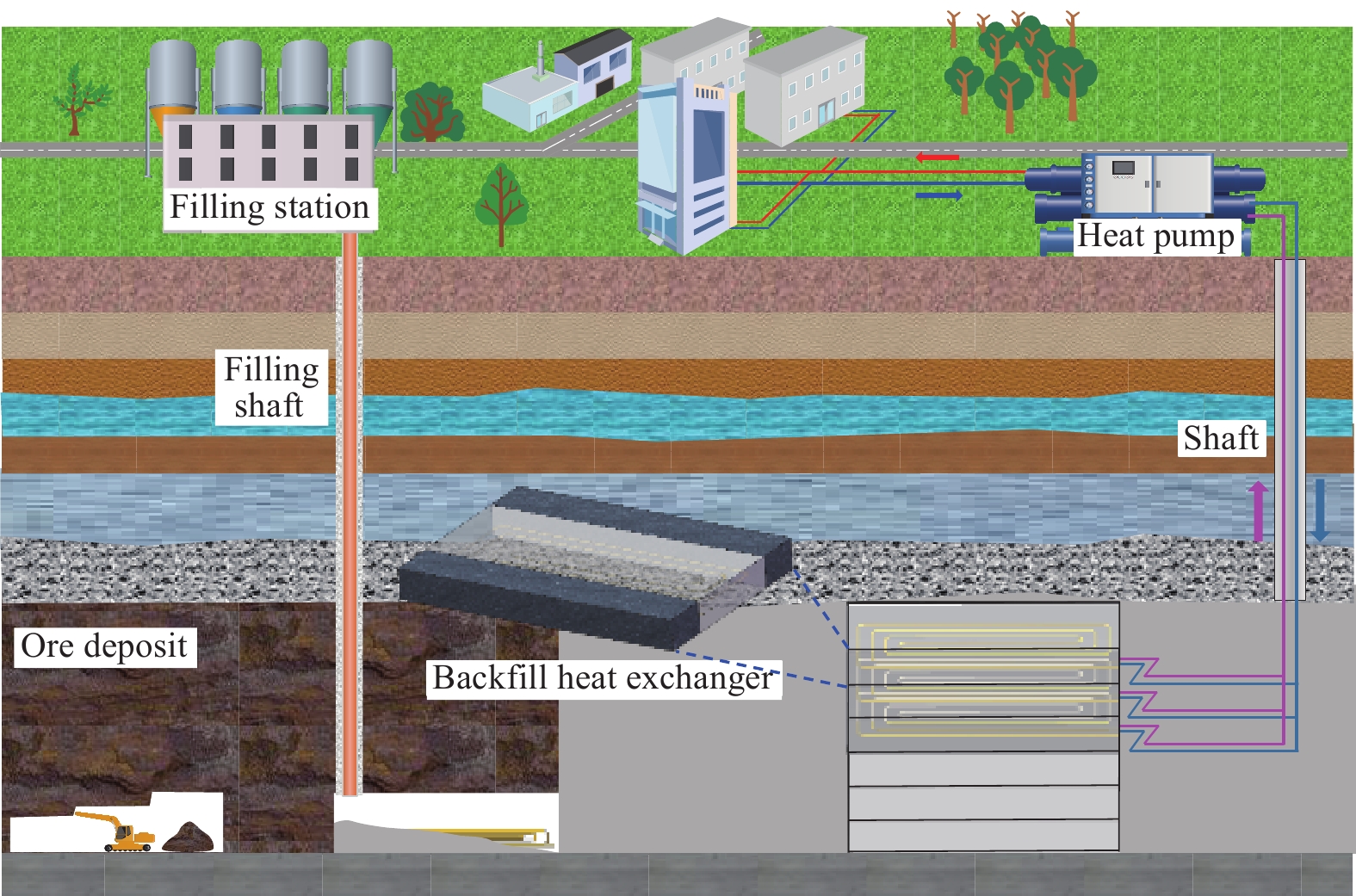
 下載:
下載:
